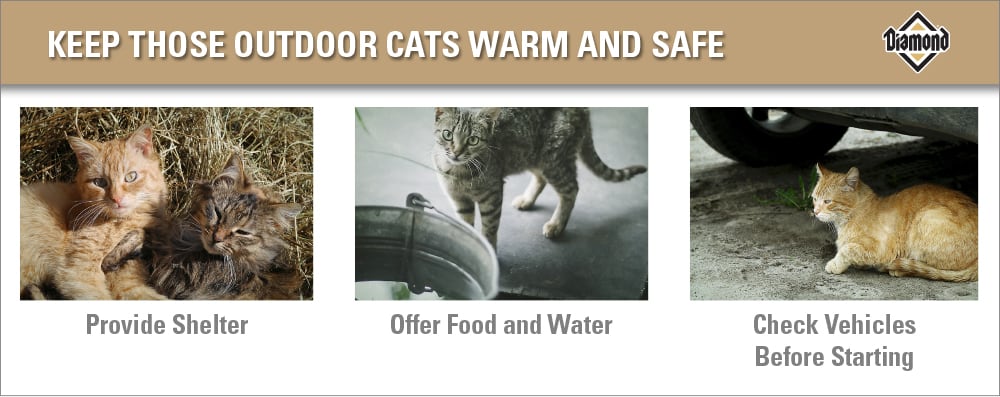Most of the time, barn cats and outdoor cats capably fend for themselves, scavenging and hunting for their meals and sheltering wherever they can. But even if these cats are built for winter — regardless of how resourceful they are — they can use some help to survive winter months, especially in areas where winter brings brutally cold temperatures and plenty of snow.
Here’s what you can do to help outdoor cats.
Offer shelter from the cold and snow
Outdoor cats need a place where they can shelter and get warm when the temperature drops. Even a thickened winter fur coat and a plethora of mice may not be enough to keep cats warm and fed during extremely cold temperatures. Cats can develop hypothermia and frostbite, just as people do, particularly when their fur gets wet from walking through snow or a cold rain.
A shelter for outdoor cats doesn’t need to be fancy or expensive. While you can buy an outdoor cat house at a pet store, you can also make one using storage totes or scrap lumber; you can also modify a dog house. According to Alley Cat Allies, an appropriate size for an outdoor cat shelter is 2 feet by 3 feet and at least 18 inches high. Cats don’t need much space, just enough for them to stand and move around. However, when weather is especially cold, cats will rely on each other for warmth, so a shelter with enough space for three to five cats allows them to huddle. For barn cats, access to an area of the barn such as a tack or storage room or an empty stall, where a sturdy box or small house-like shelter can be placed, will give cats someplace to stay warm.
Straw makes the best bedding for outdoor cat shelters because it resists moisture and helps keep the shelter warm. Blankets, towels and pet beds should not be used because they can retain moisture and even freeze, chilling cats who lay on them.
For information on how to make your own shelter for outdoor cats, check out the Alley Cat Allies’ gallery of shelters. The website also has a lot of valuable information about caring for community cats.
Provide extra food and water
Cats that live outdoors during cold weather will need more food — or at least extra calories — to help them stay warm. Like us, cats shiver when cold to maintain a constant body temperature. However, shivering uses a lot of energy (calories), which is why outdoor cats need more food during cold weather.
Either canned or dry food can be offered. While dry food doesn’t freeze during really cold temperatures, canned food will because it has a high moisture content. If you want to provide canned food, use insulated bowls and feed outdoor cats on a regular schedule. Feeding at the same times every day conditions cats when to come around, and, chances are, the canned food will be eaten before it freezes.
When choosing a dry cat food to feed during winter months, consider feeding a quality food that’s higher in protein and fat since it will also be higher in calories on a per-cup basis. An active cat food such as Diamond Naturals Active Cat Chicken Meal and Rice Formula or a kitten food such as Diamond Naturals Kitten Chicken & Rice Formula can provide the balanced nutrition — and energy — that cats need to stay warm and nourished.
As important as food is, drinkable, fresh and clean water is even more important, even in areas where it snows. You’ll want to check water bowls frequently to be sure the water isn’t frozen. Using insulated bowls can help delay freezing during cold weather.
Another potential cold weather hazard
Barn and other outdoor cats may seek shelter inside a warm car engine, up in a wheel well or simply underneath the vehicle. However, if the vehicle is started while the cat is under the hood, serious injury or worse could occur. So if you park outdoors or in a garage that cats can get into, please check before you drive. Look around the tires, bang on the car’s hood or honk the horn before starting the engine. These steps usually frighten a cat away from your vehicle and out of harm’s way.

RELATED POST: Does Winter Weather Change My Pet’s Nutrition?







